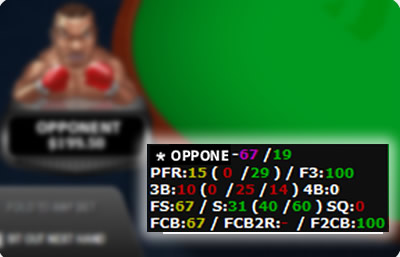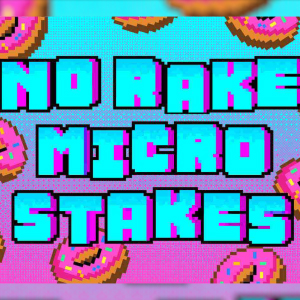Introduction to Poker HUDs (Heads Up Displays)
In poker we rely on correct and relevant information on our opponents to make the best play possible and create an edge over the games. One of the best resources to a poker player therefore is the use of a Poker HUD (Heads Up Display) which we can use to have up to date information on any player we choose. Poker HUDs come as part of the package when we purchase poker tracking software such as Holdem Manager or PokerTracker - The HUD is placed over our online poker table and gives us vital information on our opponents.
The stats we have on opposition players will include every move we have seen them make and each number can tell a different story. We can make early assumptions on a player’s tendencies (loose, passive, aggressive, tilty etc) and can work out how profitable a certain play is likely to be against them. We can also narrow down their range based on their stats which makes in play decisions easier and study moves afterwards more beneficial. Here are some of the essential stats that everyone should have on their HUD and how to use them (all of the stats used, except BB/100, are expressed as a percentage).
Pre Flop Poker HUD Stats
• VPIP- Voluntary Put In Pot
This stat tells us how often someone puts money into the pot pre flop without being forced to. This includes limping in, calling a raise and making a raise. This does not include posting blinds or antes. We can deduce from this stat how wide a players range is and therefore the likely strength of their hand. When using this stat in conjunction with PFR we can also deduce how aggressive or passive a player is likely to be and the likely ability of our opponent. If a player has a wide gap between their VPIP and PFR they are likely going to be a passive player and probably not that good.
• PFR- Pre Flop Raise
This stat tells us how often someone makes a raise pre flop. This includes open raising, raising a limp and 3bet+. We can deduce from this stat how wide of a range a player is raising and use this in correlation to how often they are playing a hand. For example if a player has VPIP of 100 and a PFR of 10 we can see that they are playing every hand and can assume they will raise the top 10% of hands. Therefore, when facing a raise from this opponent we should be aware that he has a particularly strong holding.
• 3B- 3 Bet
This stat tells us how often a player re-raises another player’s raise pre flop. For example Mid Position opens to 3x the big blind and the player sitting in the Cut Off re-raises to 10x the big blind (3.3x the original raise). We can deduce from this stat how likely someone will re-raise us and their range when they do so. When using this stat in conjunction with FvST we can make better decisions when to steal another player’s blind. If they have a low 3B and have a high FvST then raising with the intention to win the hand by the other playing folding is more appealing.
• ST- Steal
This stat tells us how often a player raises from late position which is where players will face fewer players behind them to act and thus the least amount of resistance. We can deduce from this stat how likely someone is raising with a weak holding trying to win the blinds. This stat can be used most effectively when compared to a player’s PFR: if a player has a PFR of 20 and a ST of 65 we can see that their range from late position is much wider than their usual raising range and are thus likely to be stealing. We can therefore adjust accordingly to different types of players.
• FvST- Fold v Steal
This stat tells us how often a player folds in the blinds v a late position open ie SB folding v CO & BTN opens, and BB folding v CO,BTN & SB opens. We can use this stat to pick out opponents it will be profitable to steal from. If we are in late position and the blinds both have a high FvST then stealing becomes very appealing.
Post Flop Beginner HUD Stats
• CBET- Continuation Bet
This stat tells us at what frequency a player makes a bet on the flop, Turn or River after raising pre flop. We have an individual stat for each street. We can deduce from this stat what types of hands opponents are continuing to be aggressive with post flop. For example if a player has a CBET of 40 they are likely to only continue when they flop a strong piece of the board (pair, 3 of a kind etc.) or a strong draw. We can therefore begin to play back against players who CBET a higher frequency and less against those who CBET with a lower frequency. In general if a player has a tighter range pre flop (low VPIP and low PFR) the higher CBET a player should have and vice versa.
• FvCBET- Fold v Continuation Bet
This stat tells us at what frequency a play folds when facing a CBET. We can begin to target players who have a high FvCBET by Cbetting with a higher frequency. We can deduce how likely a player is to call with weaker holdings and can therefore go for bigger value bets when playing someone who will make wide calls. This also means we can tell that a player who has a high FvCBET calls a CBET have a strong holding.
• WTSD- Went To Show Down
This stat tells us how often a player will reach showdown though calling down 1+ bets, checking down or betting and getting called. We can deduce from this stat how likely a player will reach showdown with a strong holding. This stat can be used with WSD to give us a very good idea on the strength of hands they take to showdown. We can adjust our bet sizing and go for thinner value v players with a high WTSD stat when making river value bets.
• WSD- Won at Show Down
This stat tells us how often a player wins money at showdown. We can use this stat to determine how thinly a player calls down the showdown and/or bets too thinly on multiple streets. We can make bigger value bets v player with a low WSD but can also make more bluffs v players who have a very high WSD as they likely have a very narrow calling range consisting of nutted hands.
• BB/100- Big Blind Won/100 Hands
This stat refers to a player’s results. If a player wins one buy in over 1,000 hands thy have won 100bb and thus 10bb/100 hands. It is a quick and easy way to measure the success of a player but requires a large sample (100,000+ hands) to be representative of their true ability. If you have played a TAG style then a good BB/100 is 2-5bb/100. .
Final Word
It is important to mention that you should not be “aiming” for these poker HUD stats whilst playing as they should come naturally to you. If some of your stats are slightly out of the recommended parameters do not assume you are playing a losing style. Everyone has different stats as everyone takes a different approach to different hands. If you find some of your stats are way out of the recommendations it is likely you have a sizeable leak and could be massively affecting your win rate.


